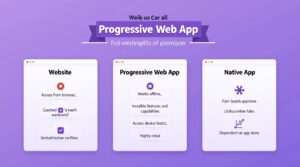click to get service View profile
Learn how to use UX writing to design great user experiences. Discover key principles, real-world applications, and strategies to enhance usability, clarity, and user engagement through effective microcopy.
In today’s digital landscape, users expect more than just visually appealing interfaces — they crave clarity, empathy, and seamless interaction. This is where UX writing plays a critical role. Often overlooked, UX writing is the invisible force that guides users, builds trust, and makes complex systems feel intuitive. It’s not just about choosing the right words — it’s about designing communication that aligns perfectly with the user’s journey. In this blog, we’ll explore how effective UX writing enhances usability, drives engagement, and ultimately helps create exceptional user experiences.
What Is UX Writing?

UX writing is the practice of crafting the words that appear within digital products — from buttons and error messages to onboarding screens and tooltips. Unlike traditional copywriting, which focuses on persuasion or marketing, UX writing is all about usability and clarity. Its goal is to guide users through an interface effortlessly, helping them complete tasks, understand information, and feel confident at every step.
Think of UX writing as the voice of the product — it gives personality to interfaces while ensuring the language is clear, concise, and useful. Whether it’s labeling a CTA (“Sign Up”) or writing a friendly 404 message, every word is strategically chosen to enhance the user experience.
Why UX Writing Matters in Design
Great design isn’t just about layout, color, or typography — it’s also about how a product communicates with its users. That’s where UX writing comes in. Clear, purposeful text can make the difference between a smooth user experience and a frustrating one.
Here’s why UX writing is essential in design:
- Reduces confusion: Well-crafted microcopy explains what actions users should take, what to expect next, and how to fix issues — all without overwhelming them.
- Builds trust: Friendly, consistent, and transparent language makes the product feel more human and reliable.
- Improves usability: Clear instructions and helpful feedback reduce errors and help users achieve their goals faster.
- Strengthens brand voice: UX writing is a key tool in expressing a brand’s personality, tone, and values throughout the interface.
- Increases engagement: By guiding users with thoughtful language, you improve onboarding, retention, and conversions.
In short, words are design too — and when used intentionally, they help create experiences that are not just functional, but delightful.
Key Principles of UX Writing
To create user-friendly and effective microcopy, UX writers follow a set of core principles that ensure clarity, consistency, and empathy in communication. Here are the key ones:
1. Clarity
Your writing should leave no room for confusion. Users should immediately understand what an action or message means. Avoid jargon and use simple, direct language.
Example:
Instead of “Authentication Required”, say “Please log in to continue.”
2. Conciseness
Respect the user’s time and attention. Say only what’s necessary to guide them, without clutter.
Tip:
Write like you’re texting a friend — short, helpful, and to the point.
3. Usefulness
Every piece of text should serve a purpose: guiding, informing, or supporting the user. Avoid filler content or vague statements.
4. Consistency
Stick to consistent terminology, tone, and style throughout the product. This helps users build familiarity and trust.
Example:
If you use “Log in” in one place, don’t switch to “Sign in” elsewhere.
5. Empathy
Understand what your users might be feeling at each step, especially during errors or complex flows. Write with compassion and encouragement.
Example:
Instead of “Invalid input”, say “Hmm, that doesn’t look right. Try entering a valid email address.”
6. Action-Oriented
Guide users toward the next step by focusing on actions they can take.
Example:
Buttons should say things like “Upload Resume” instead of a vague “Next.”
Where UX Writing Appears in a Product

UX writing is everywhere — not just in the obvious places like buttons or menus, but woven throughout the entire user journey. Every touchpoint is an opportunity to guide, inform, and connect with users. Here’s where UX writing typically shows up in a digital product:
1. Buttons & CTAs (Calls to Action)
Clear, actionable text like “Get Started,” “Download Now,” or “Continue” helps users know exactly what will happen when they click.
2. Form Fields & Labels
Input hints, field labels, and validation messages reduce user errors and confusion during form-filling.
Example:
Label: Email Address
Hint: We’ll never share your email.
3. Error Messages
Empathetic and helpful messages explain what went wrong and how to fix it, instead of just showing red text.
Bad: Error 404.
Good: Page not found — try going back or checking the URL.
4. Onboarding Instructions
Step-by-step guides or tooltips that welcome new users and show them how to use your product effectively.
5. Navigation Menus
Menu item labels like “Dashboard,” “My Profile,” or “Settings” should be intuitive and reflect real user language.
6. Empty States
When there’s no content to show yet, UX writing can guide users on what to do next or reassure them.
Example:
You haven’t added any tasks yet. Let’s start with your first one.
7. Notifications & Alerts
UX writing helps users understand important updates, actions required, or background processes (like “Saving…” or “Update completed”).
8. Tooltips & Microcopy
Small hints that offer extra information without overwhelming the interface.
Example:
Hovering over a help icon might show: Password must be at least 8 characters.
How to Apply UX Writing in Real Projects
Effective UX writing doesn’t just happen by chance — it requires a strategic approach and collaboration with design and development teams. Here’s how to apply UX writing in your real-world projects:
1. Understand the User
Before you start writing, gain a deep understanding of your target audience. Who are they? What are their goals, pain points, and emotional triggers? This understanding will help you craft messages that resonate with users at every touchpoint.
Actionable Tip:
Conduct user interviews, surveys, or review user personas to identify common pain points and language preferences.
2. Collaborate with Designers and Developers
UX writing is most effective when integrated early in the design process. Work closely with designers to ensure that the words complement the visuals and that the text flows logically with the interface. Similarly, coordinate with developers to ensure that text fits well into UI components without breaking the layout.
Actionable Tip:
Involve the UX writer in wireframe discussions, ensuring the text and design are aligned from the start.
3. Create a Content Style Guide
A consistent voice and tone across the product are crucial. Develop a style guide that defines language conventions, tone, and terminology. This will serve as a reference for everyone on the team, ensuring consistency and clarity.
Actionable Tip:
Include rules for using active vs. passive voice, how to handle form labels, preferred error message formats, and tone for different user scenarios.
4. Write with Clarity and Brevity
Apply the principles of clarity, conciseness, and usefulness. Whether it’s a CTA button, an error message, or an onboarding instruction, ensure your copy is easy to understand and gets to the point.
Actionable Tip:
Avoid complex phrases or unnecessary technical terms. Opt for simple language that your users will immediately understand.
5. Use Empathy in Critical Moments
Especially in moments of frustration or confusion (e.g., error states or failed actions), write with empathy. Acknowledge the user’s frustration, explain what went wrong, and guide them on how to resolve the issue.
Actionable Tip:
Use phrases like “Oops, something went wrong. Let’s try again” instead of blunt error codes.
6. Test and Iterate
Like any part of design, UX writing should be tested. Use A/B testing for CTAs, run usability tests to see how users interact with the text, and gather feedback from actual users. Iterate based on feedback to continually refine the writing for better results.
Actionable Tip:
Track conversion rates or task completion rates for different versions of copy to see what works best.
7. Focus on the User Journey
Write text that seamlessly guides users through their journey. Whether they’re signing up, completing a purchase, or checking out, ensure the copy is relevant and helpful at every stage of the process.
Actionable Tip:
Map out the entire user flow, ensuring each piece of text aligns with the user’s current context and needs.
Examples of Strong UX Writing
| Poor Copy | Improved UX Writing |
|---|---|
| Error | Something went wrong. Try again. |
| Submit | Send Request |
| Click here | Learn more |
| Invalid | Please enter a valid email address. |
Measuring the Impact of UX Writing

While UX writing is often seen as subtle or invisible, its impact on user experience is significant. To ensure that your UX writing is making a positive difference, it’s essential to measure its effectiveness. Here’s how you can assess the impact of your copy:
1. User Feedback
One of the most direct ways to measure the effectiveness of UX writing is through user feedback. Surveys, interviews, or usability testing can give you valuable insights into how users perceive the clarity, tone, and usefulness of the text.
Actionable Tip:
Ask specific questions like, “Did the instructions help you understand what to do next?” or “How did you feel about the error message you saw?” to gauge emotional and functional responses.
2. Conversion Rates
Conversion rates — such as sign-ups, purchases, or task completions — are direct indicators of the effectiveness of UX writing. Small changes in CTAs, form field instructions, or even error messages can lead to significant changes in how users engage with the product.
Actionable Tip:
Run A/B tests on different variations of key microcopy (e.g., CTA buttons) and track the results to see which version drives better conversions.
3. Task Success Rate
In usability tests, measure the task success rate — the percentage of users who successfully complete specific tasks (like completing a purchase or submitting a form). Poorly written microcopy can often lead to higher abandonment or error rates, so this is a good indicator of whether your writing is supporting users effectively.
Actionable Tip:
Monitor user behavior on tasks with critical copy elements (like error messages or instructional text) and identify areas where users struggle.
4. Error Rate
An effective error message or instruction can reduce user frustration and guide them toward a solution. By tracking the error rate (how often users encounter problems during a process), you can assess how well your writing is helping users avoid or recover from mistakes.
Actionable Tip:
Review where users are dropping off or making mistakes in the interface. Analyze the copy around those areas — does it provide clear guidance to prevent errors?
5. Engagement Metrics
For digital products like apps or websites, engagement metrics (e.g., time spent on a page, interactions, or bounce rates) can reflect how effectively your copy engages users. If users are interacting more, staying longer, and moving through the interface smoothly, it indicates that the UX writing is playing a positive role in their journey.
Actionable Tip:
Track metrics like average session duration and bounce rates before and after changes to key pieces of UX copy to measure improvements.
6. Customer Support Requests
Monitor the volume and type of customer support requests related to confusion around the interface. If users frequently contact support for help with certain steps, it could indicate that the copy isn’t clear enough.
Actionable Tip:
Analyze the common issues raised by users. If the same problems are happening repeatedly, review the copy in those areas and consider making adjustments for better clarity.
7. Retention and Return Rates
In SaaS products or apps, retention and return rates can reflect how well your product’s writing supports user needs over time. Users who return to the product are more likely to be engaged with the experience and find the communication helpful.
Actionable Tip:
Measure how changes in UX writing impact user retention, especially in critical flows like onboarding or first-time use.
Conclusion
UX writing is more than just words on a screen — it’s a key element in crafting meaningful, intuitive, and delightful user experiences. By following principles of clarity, empathy, and consistency, UX writers help guide users through digital interfaces, ensuring they feel understood, supported, and empowered at every step.
As you design and refine user experiences, remember that every piece of text — whether it’s a call-to-action, an error message, or an onboarding instruction — has the potential to shape how users perceive and interact with your product. When done right, UX writing can improve usability, boost engagement, and drive long-term success.
So, next time you’re creating or refining a digital product, don’t overlook the power of words. Embrace UX writing as an essential tool in your design process, and watch how it elevates the overall user experience.

